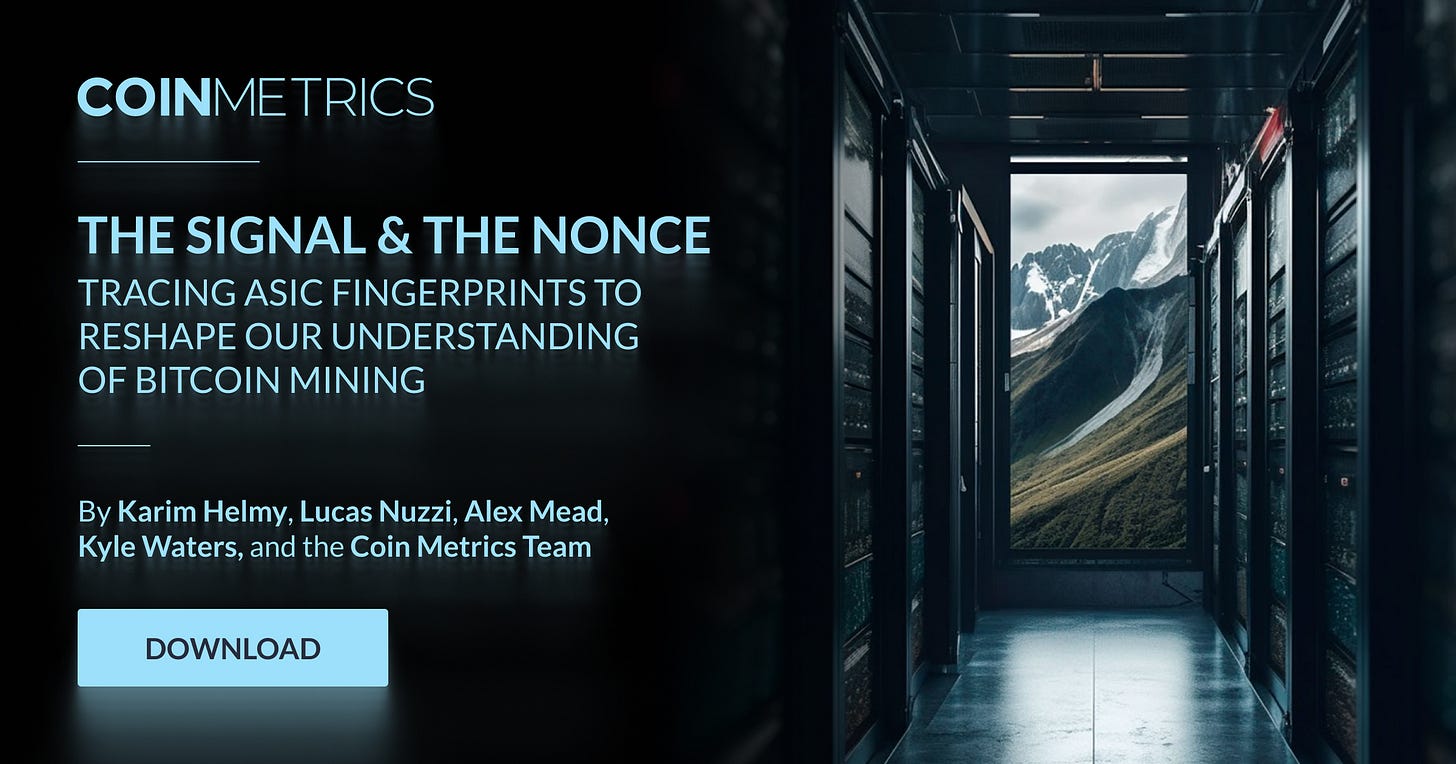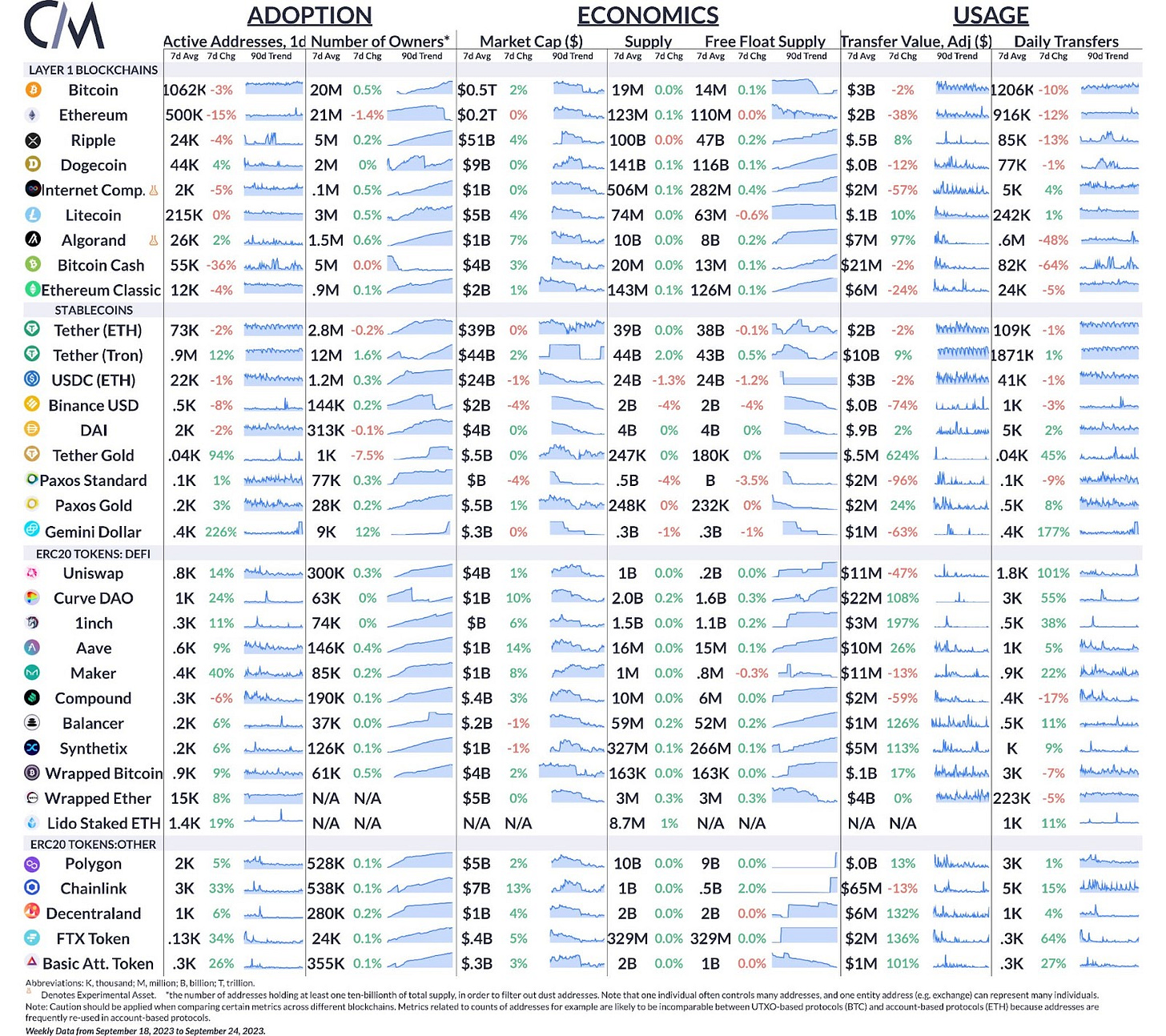Coin Metrics’ State of the Network: Issue 226
State of the Network’s Q3 2023 Mining Data Special
Get the best data-driven crypto insights and analysis every week:
State of the Network’s Q3 2023 Mining Data Special
By Parker Merritt & Kyle Waters
In this week’s State of the Network, we return with our quarterly mining data special, where we provide a close examination of the current Bitcoin mining landscape through the lens of Coin Metrics’ data.
BTC Hashrate Surges to a new High
Despite a flat BTC market in the back half of Q3 as spot ETF chatter quieted, hashrate continued to accelerate throughout the quarter, recently hitting a new high of around 400 EH/s from 250 EH/s at the beginning of 2023. Hashprice conditions remain challenging, yet savvy miners continue to add operational hashrate.
Source: Coin Metrics Network Data
Since the 2021 mining ban in China, the United States has emerged as the clear focal point of a maturing Bitcoin mining industry. Financed by the strength of US capital markets, publicly-traded mining companies and their required disclosures are a great place to gauge US hashrate trends. Recently, US-headquartered miner Marathon (NASDAQ:MARA) reported that its operational hashrate grew to 17.7 EH/s through Q2 ‘23 (almost 5% of the total network hashrate), up from 11.5 EH/s in Q1. On a total installed basis, the company also reported 23 EH/s installed in the US, with a target of 30 EH/s of total anticipated hashrate. Riot Blockchain (NASDAQ:RIOT), another US-based miner, similarly reported growth in deployed hashrate from 4.8 EH/s in August 2022 to 10.7 EH/s as of August 2023. Across all North American operations that are self mining (e.g. non-hosted mining), operational hashrate stood at around 93 EH/s per Compass Mining’s aggregations, representing just close to 25% of the network hashrate.
After a punishing 2022, mining stocks have mostly rebounded in 2023 alongside BTC. Another positive trend for US miners is subsiding inflation pressures, with US energy prices falling YoY nationwide (per US EIA data ending in June). In miner-friendly Texas, the average industrial rate fell to $0.0674 / kWh, from $0.0749 / kWh the year prior. While political action still remains a risk, US miners also notched a win with the White House’s proposed tax on mining (the “DAME” tax) being tossed out in the Debt Ceiling agreement earlier this year.
With the next halving less than a year away, US miners are ramping up production while also managing their fleets ahead of the inevitable decline in block rewards come next spring. We can see this in the data on the average network wide efficiency, which has continued to trend towards a more efficient overall network (per Coin Metrics Labs’ MINE-MATCH). Generally speaking, US miners are deploying more modern machines, leading to a continued increase in network wide efficiency. The stakes will also be raised next year with the expected launch of the state of the art Antimer S21. ASIC manufacturer Bitmain recently announced the S21 will start shipping in Q1 and Q2 of 2024. The arrival of a vastly more performant machine (with reported specs of a 200 TH/s hashrate and 17.5 J/TH efficiency) will further add to the complexity of the mining landscape in 2024.
The maturation of the mining industry has implications elsewhere, though. For example, concentration of hashrate in the hands of a few massive mining pools remains a major concern for the Bitcoin community. Since January 2023, Foundry and Antpool have collectively controlled north of 50% of Bitcoin’s hashrate, posing ever-greater centralization risk. Though Foundry’s dominance has softened to 29% from the high of 34% in February, Antpool is inching forward, gaining 5% share over the same period to reach 23%.
While the Foundry and Antpool are popular targets of ire when it comes to centralization risk, a recent incident with F2Pool— the 3rd-largest mining pool with 13% share—has invited a fresh wave of introspection about the role of mining pools and their influence over transaction settlement.
F2Pool Forgoes $500K Fee
Founded in 2013, F2Pool’s main claim to fame is being China’s “first mining pool.” Even as rival mining pools have come and gone, F2Pool has maintained a strong foothold in the top 3 mining pools, raking in $900M in block rewards and $40M in transaction fees so far in 2023.
Source: Coin Metrics ATLAS and Reference Rates
F2Pool’s fate is tied to the bold personality of founder Chun Wang, who is no stranger to controversy. On September 10, on-chain analysts spotted an extraordinarily large transaction fee paid to F2Pool. From the very beginning, the transaction was recognized as a fat-finger overpayment error, shelling out a record $510,750 in fees for an otherwise ordinary transfer of 0.074 BTC. Chun Wang publicly acknowledged the fee was undoubtedly paid in error, assuring that F2pool would only redistribute the ~20 BTC sum to miners “if nobody comes to claim it after three days.”
At first, social media speculated the transfer originated from a PayPal address. Eventually, Paxos issued a statement claiming responsibility for the mistake. Though F2Pool founder Chun initially agreed to refund Paxos, he later expressed regret about his decision, crowdsourcing opinions on Twitter (a.k.a. X).
In the end, Chun honored his commitment to refund Paxos, reimbursing the full 19.821 BTC fee from their massive pool wallet. The transaction came lumped with a chunky 750 BTC change output (credited directly back to the pool’s main address), and was mined by F2Pool themselves with a privileged “zero-fee” transfer.
Though the F2Pool founder’s response to the incident earned him the goodwill of a potential business partner (and possibly an under-the-table finder’s fee), the decision to refund Paxos stoked division and outrage in the mining community. Many onlookers sided with Wang, applauding the “humane decision” to nullify a very human mistake. Others equated F2Pool’s refund to “stealing from their own miners.”
In any case, the lack of transparency on policy & process adds to a mounting sense of skepticism towards mining pools.
The Curious Case of Zero-Fee Transactions
On the other end of the fee market extreme, F2Pool is yet again an outlier. Economic incentives dictate that miners should select the highest-paying transactions for inclusion in a block, maximizing the potential reward in an environment of increasingly-scarce blockspace.
Nonetheless, on occasion some pools will mine zero-fee transactions. These transactions are “free riders,” filling up precious blockspace without paying the commensurate sat/vB fee. In Q3 2023, nearly all of these zero-fee transactions were mined by F2Pool, displacing around $25,000+ in potential fee revenue— a meaningful sum in a period of razor-thin mining margins.
So why would a mining pool waste precious blockspace on transactions with zero fees? Many of these zero-fee transactions are linked to “internal operations” of the mining pool. Once per day, a single F2Pool-mined transaction takes up 10% of the available blockspace. These are mining pool payouts, initiated from F2Pool’s own address to thousands of miners contributing hashrate to their pool.
Other “internal” transactions are modest in size, taking up just 0.5% of blockspace. These transactions are simply shuffling F2Pool funds between pool-controlled addresses for accounting & fee management purposes.
However, the vast majority of zero-fee transactions—particularly those in the lowest ‘block capacity’ tranche— don’t match the expected format of a typical “internal operation” for F2Pool.
Digging deeper into the transaction metadata, many of these transfers contain an OP_RETURN output. Once widely utilized for the creation of tokens & NFTs, Bitcoin’s OP_RETURN field allows users to embed arbitrary data into the blockchain (though Bitcoin Core developers later imposed strict size limits). The Stacks blockchain currently leverages the field as a BTC-linked consensus mechanism known as Proof-of-Transfer (PoX). These “Stacks block commits” can be identified by any OP_RETURN that begins with a X2[ prefix.
Nearly the entire “lower band” of zero-fee transactions mined by F2Pool consist of Stacks block commits, indicating the pool is earning cost-free revenue on the side by participating in Stacks consensus. What’s more, the majority of these blocks contain zero other Stacks block commits, meaning F2Pool is the sole winner of the STX reward. This implies F2Pool is censoring other block commits in an attempt to maximize their own STX revenues. Though the co-creator of Stacks claims an upcoming upgrade will make the protocol more resistant to this manipulation, F2Pool currently retains final authority over all Stacks-coded transactions in their blocks.
At the moment, the Stacks blockchain pays out 1,000 STX per block mined. Based on the number of zero-fee Stacks blocks F2Pool solo-mines on a daily basis (multiplied by the value of STX), we can make a lower-bound estimate of USD revenue F2Pool has earned via Proof-of-Transfer— In Q3, over $400,000.
Source: Coin Metrics ATLAS and Reference Rates
Setting aside pool operations and Stacks block commits, the remaining handful of zero-fee transactions require a more in-depth inspection to uncover their origins.
Many of the transactions weren’t ever broadcasted to the public mempool. Instead, they appear to have been pushed directly to F2Pool, leveraging the pool’s new Transaction Accelerator service. The Accelerator allows users to bypass the mempool entirely, paying a USDT-denominated fee for a priority slot in F2Pool’s next block. While the pool doesn’t explicitly reveal their pricing model, quotes appear to vary based on transaction size, ranging from $30 to $3,000. On-chain flows link the Accelerator deposit address to ERC-20 wallet b80…ec1, potentially controlled by F2Pool or a partner exchange. While it's unlikely all of the address’s activity is linked to Transaction Acceleration, the frequency of USDT inflows hints the pool earns a substantial amount of revenue by facilitating out-of-band payments.
Conclusion
As additional ecosystems and applications begin to anchor themselves to Bitcoin's proof-of-work, mining pools will have strong incentives to circumvent the mempool and pocket the proceeds. Going forward, miners will be forced to demand a higher level of transparency from their pools. Is the pool brokering under-the-table transactions? Should miners get a cut of the pool’s STX revenue? The days of simply plugging into the lowest-fee pool are over— just as the ETH fee market has zeroed in on MEV machinations, the modern age of Bitcoin mining will be increasingly infiltrated by off-chain arbitrage.
Make sure to check out our previous issues of the mining data special, as well as our June report The Signal & the Nonce: Tracing ASIC Fingerprints to Reshape our Understanding of Bitcoin Mining.
Network Data Insights
Summary Metrics
Coin Metrics Updates
This week’s updates from the Coin Metrics team:
Coin Metrics is pleased to announce the version 2.9 release of our CM Market Data Feed. This release contains support for data types from many more exchanges, new funding rate metrics, easier ways to query our data, and many more upgrades and bug fixes.
As always, if you have any feedback or requests please let us know here.
Subscribe and Past Issues
Coin Metrics’ State of the Network, is an unbiased, weekly view of the crypto market informed by our own network (on-chain) and market data.















